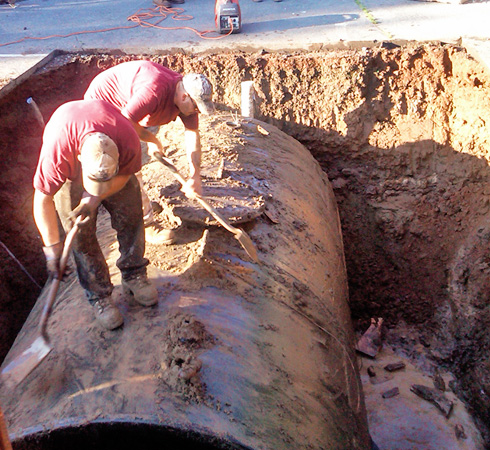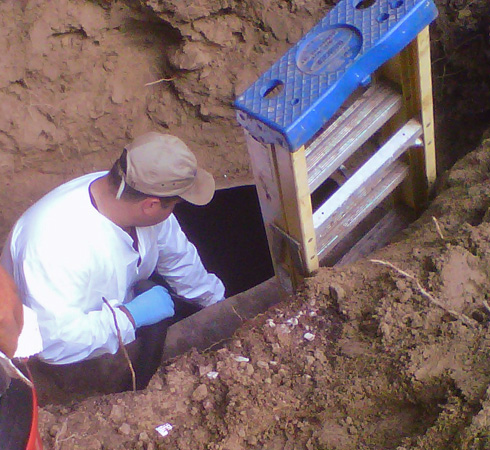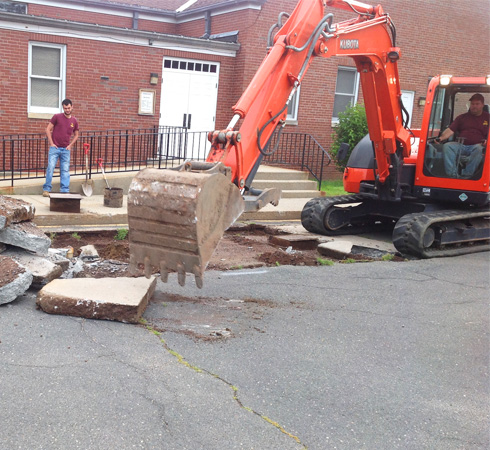Tank FAQ’s | Storage Tank Removal – Installation – Replacement
 Whether you need an oil storage tank removed, installed, or replaced, turn to the pros at R&R Landscaping & Storage Tank Removal. Serving the Hartford, New Haven, and Middletown CT area, including Avon CT, Windsor CT, Willimantic CT, Newington CT, Glastonbury CT, Wallingford CT, Bristol CT, Colchester CT, and more.
Whether you need an oil storage tank removed, installed, or replaced, turn to the pros at R&R Landscaping & Storage Tank Removal. Serving the Hartford, New Haven, and Middletown CT area, including Avon CT, Windsor CT, Willimantic CT, Newington CT, Glastonbury CT, Wallingford CT, Bristol CT, Colchester CT, and more.
How long do oil tanks last?
The average life of an underground storage tank (UST) is 15-20 years. Underground storage tanks installed after the 1988, when the federal government and Environmental Protection Agency (EPA) increased regulations and required anticorrosion coating, can last for up to 30 years. How long an underground storage tank lasts depends upon soil conditions and installation as much as it does upon what material it is constructed out of. Tanks installed improperly or in poor soil conditions will have a significantly shorter life.
Above ground storage tanks (ASTs) can last for up to 60 years if they are made of thick, high-quality steel. It is also important to make sure that water does not get into the tank. Allowing water into the tank will speed up the process of corrosion and significantly reduce the lifespan of an above ground storage tank.
What are signs that my underground oil tank is leaking?
Whether you have an underground oil tank or an above ground oil tank there are four warning signs that indicate an oil leak:
- Dead plant life around the vicinity of the tank
- Rapid oil consumption that is disproportionate to the amount you are using
- A rainbow-like sheen or oil-slick sheen in puddles of water near the tank
- The odor of fuel in your yard or house
All of these signs are indications of significant contamination. If you have an above ground oil tank, there are other signs that you can look out for to catch a leak before the contamination reaches this point. Unfortunately, if you have an underground tank, it is difficult to catch a leak in the early stages.
What should I look for when I inspect my above ground storage tank?
The greatest advantage of an above ground oil tank is that you can catch leaks early by routinely performing visual inspections. These are warning signs to look out for when you are doing visual inspections:
- Rust or wet spots on the tank’s exterior
- Drips or signs of leaking around the valves, fitting, fuel delivery line, piping, or tank
- The strong odor of oil around the tank
- Oil stains on the ground surrounding the tank
- Uncovered fuel lines that do not have a protective casing
- Disconnected fuel-fill lines from an old tank that should have been removed
- A stuck, frozen or cracked fuel-level gauge or oil stains around the gauge
- Ice, snow or an insect nest restricting or clogging the tank’s vent
- Loose, bent, wobbly or rusty tank legs or a cracked foundation indicate that the tank is not stable (sturdy legs and a sound foundation are essential for an above ground storage tank because a full 275 gallon tank can weigh more than 2,000 pounds)
- signs of patch concealing a leak
- Dead plants near the base of an outdoor tank
- Overhanging eaves above an outdoor tank that would allow melting snow or ice to fall onto the tank increasing the risk of corrosion
If you notice any of these signs, contact a licensed professional who can do a thorough inspection and take action quickly before you have a serious leak to cleanup.
What should you do if my oil tank has a leak?
 If your tank has leaked, the first step is to ensure your safety. Do not smoke or light any matches in the area. Keep in mind that oil can extend far beyond where the tank is located. It can flow into cracks and drains, get beneath floor boards, seep into walls, and saturate soil. If you have an above ground oil tank, turn off all sources of flames or sparks such as the pilot light of a nearby furnace or water heater. Also, be sure to ventilate the area around the leak by opening cold-air returns, heat registers, and windows. In this process you should still try to prevent oil saturated air from flowing into other areas of your home. Keep pets and small children away from the area! Afterward, discard any clothing or furniture that has absorbed the smell of oil.
If your tank has leaked, the first step is to ensure your safety. Do not smoke or light any matches in the area. Keep in mind that oil can extend far beyond where the tank is located. It can flow into cracks and drains, get beneath floor boards, seep into walls, and saturate soil. If you have an above ground oil tank, turn off all sources of flames or sparks such as the pilot light of a nearby furnace or water heater. Also, be sure to ventilate the area around the leak by opening cold-air returns, heat registers, and windows. In this process you should still try to prevent oil saturated air from flowing into other areas of your home. Keep pets and small children away from the area! Afterward, discard any clothing or furniture that has absorbed the smell of oil.
If you suspect that tank has leaked into the ground and impacted the soil surrounding the tank, a licensed professional like R&R who specializes in tank removal and remediation should be contacted right away. Taking action sooner rather than later will help prevent the spread of pollution which will save you money in the long run and protect your health. You are liable for all of the pollution caused by your leaking oil tank even if it extends to others’ property. Once the tank is removed and the contaminated soil is remediated a report will need to be submitted to Connecticut’s Department of Energy & Environmental Protection (DEEP)’s Emergency Response and Spill Division. You should also contact DEEP’s Remediation Division if pollution has reached surface water or a drinking water well. A contractor like R&R can help you with all of the legal paperwork.
Can I have a new underground storage tank installed instead of an above ground storage tank?
You can have a new underground storage tank installed but it is not recommended. Since underground tanks have a shorter lifespan and their leaks can go undetected for a significant amount of time, they pose a far greater liability. Many banks and insurance companies require an above ground oil tank.
What is done with contaminated soil, old tanks and their contents?
The residual oil and sludge that is removed during the process of cleaning out an oil tank is recycled at a waste oil recycle facility where it is reprocessed. Once the old tank is clean, it will be taken to a licensed scrap metal processor or another approved disposal site. Soil that has high levels of contamination will be trucked away to a HAZMAT-certified incinerator.
What is a closure report & do I need one for my oil tank removal?
A closure report is a document that describes the removal of an oil tank and any cleanup procedures that were completed for leaks or spills. It also includes ETPH reports from the lab.
 Realtors, lending institutions and buyers often want to see a closure report as proof that an underground tank has been removed.
Realtors, lending institutions and buyers often want to see a closure report as proof that an underground tank has been removed.
How much will it cost to have my old tank removed and a new tank installed?
There are a number of different variables that affect the cost of removing and replacing an oil tank. The best way to get an accurate estimate is to have a professional visit your property. If you are located in Ellington, Connecticut or the surrounding area, reach out to us at R&R! We will be happy to give you a free estimate. Serving commercial and residential customers throughout Central Connecticut for more than 20 years.

 Tap to Call Now
Tap to Call Now